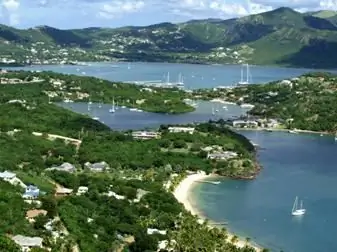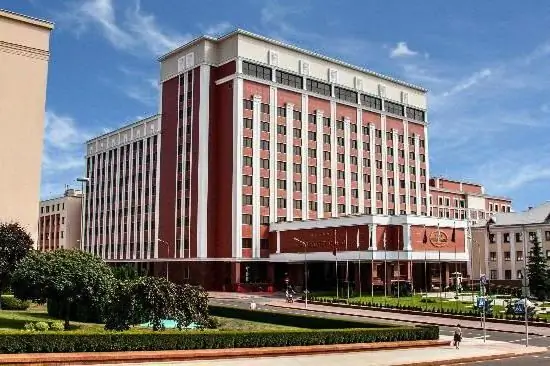- Author Harold Hamphrey [email protected].
- Public 2023-12-17 10:06.
- Last modified 2025-01-24 11:10.
The Danube is the longest river in the EU and the second largest in Europe. It flows through nine countries, originating in the Black Forest mountains (Germany) and flowing into the Black Sea on the border of Romania and Ukraine. The length of the river is impressive - almost three thousand kilometers! Not far from Budapest, this large water artery bends in a long arc, forming the so-called bend of the Danube. Excursions, reviews, trip descriptions will be covered in our article.
In principle, along the Danube bend you can also go on an independent trip by taking a ticket for a river cruise. But this, firstly, is expensive, and secondly, you will not know even a hundredth of the information that the guide will tell you. Tours are easy to get. Most often they are organized from Budapest. Private, in a private guide car, or group, in a comfortable air-conditioned bus, all of them will leave you with the most positive experience.

Where is locatedBend of the Danube
Flowing through the territory of Slovakia, the majestic river tends from west to east. But near the Hungarian border town of Esztergom, it makes a sharp turn to the south. Further, the Danube flows, meandering, to the northernmost tip of Budapest. In the very center of the bend is the ancient town of Vysehrad. The explanation for this natural landmark is very simple.
The Danube runs into mountainous terrain in its course. The steep terrain makes the river meander. On the right bank of the bend are the Visegrad Mountains, and on the left - the Berzhen massif. But the Danube Bend is not just a natural attraction that is pleasing to the eye. Along the banks of the river are small towns and feudal castles, whose history and color will undoubtedly delight you. Traveling along the Danube bend is a favorite pastime of Hungarians and Slovaks.

When is the best time to go on a tour
Any travel agency in Budapest writes down those who want to make this exciting trip. There are no season restrictions. But those who have already been on the “Bend of the Danube” excursion from Budapest mention that in winter (more precisely, in January and February), Visegrad Castle is closed. Instead, the guides take the group further north, into Slovakia, stopping at the Maria Valeria Bridge to take a spectacular photo of the entire panorama of the river bend. At other times, the extreme northern point of the excursion is the Hungarian city of Esztergom. What is more interesting for you, a museum exposition of a medieval castle or a check-in on the territorySlovakia, you decide.
You should also refrain from traveling on Monday, because on this day all museums and most churches are closed. In group excursions, which last about ten hours, lunch is provided for participants, as well as tasting of local wines. In an individual tour, the program and meals are discussed with the guide. Lunch and entry to most museums (except the Visegrad Castle Museum) are included in the price of the tour. And the price of the tour depends on the bureau and fluctuates around 50 euros (4 thousand rubles). An individual tour with a private guide will cost two to three times more (depending on the program).

Journey summary
The group leaves for the bend of the Danube from Budapest. Moreover, some tour operators practice the service of collecting excursion participants at addresses. This, of course, is convenient, tourists mention in the reviews, but only for those who are taken last. It takes a long time to drive through the streets of Budapest. First, the bus goes to Esztergom, the northernmost point of the journey. There, tourists look at the majestic cathedral and - across the river - at the Slovak city of Sturnovo.
Then the participants of the excursion go to Visegrad. A visit to the castle is optional. Those who are not interested in history can be satisfied with shopping down in the town. But the guided tour has already been paid for, all that remains is to buy entrance tickets to the castle (1700 forints or 400 rubles per adult, children under 6 years old are free). After Vysehrad, the group travels to Szentendre, the former capital and the "Hungarian Montmartre". Thereparticipants visit the Museums of marzipan and Christmas decorations. Lunch and tasting are provided in the same city.
Estergom
It's hard to believe now, but the small border town was the capital of Hungary instead of Budapest for 250 years. The bend of the Danube is just beginning here, and sightseers are specially taken to look at it from the viewing platform. Now Esztergom has the glory of the "spiritual capital". The number of churches here is impressive. But the largest in Hungary, and at the same time the most ancient, is the Basilica of St. Adalbert.
From its dome, panoramic views of the entire city open up. Don't forget to look into the crypt where the treasury is kept. The first monarch of Hungary, Istvan (XI century), was born in Esztergom, who was also crowned here. Not far from the Basilica, one can see the ruins of his palace with a museum exposition of artifacts found here. A bus with sightseers passes the village of Nagymaros, where a church from the 14th century has been preserved.

Visegrad Castle
This fortress is much older than the state of Hungary itself. Even the ancient Romans built a fortress on top of a steep cliff above the bend of the Danube, which served as a frontier outpost of the entire Western Empire, protecting it from eastern barbarians. The successful strategic position of this castle was also appreciated in the feudal era. Beginning with King Matthias, several generations of monarchs used Vyšehrad as the capital of Hungary. When its status passed to Budapest, the castle did not lose its significance. The kings made it their summer residence.
Visegrad suffered greatly in the wars, especially in the battles with the Habsburgs. But some towers survived. Guides in all seriousness assure that one of them contained Dracula himself. And what - Vlad Tepes was a completely historical person. He owned a castle in neighboring Transylvania (the Romanian part of the Carpathians bordering Ukraine). The town of Vysehrad itself is cute and sleepy. Those who do not want to climb to the top of the cliff can wander its narrow cobbled streets and buy souvenirs.

Sentendre
The name of this ancient town, founded back in the 11th century by King Istvan, translates as "Saint Andrew". In the XIII century, the Tatar-Mongolian troops burned it to the ground. A century later, the city was rebuilt by Greek and Serbian refugees. Therefore, there are so many Orthodox churches in Szentendra, and a truly Balkan atmosphere reigns on the streets. And the city, surprisingly, also had a chance to visit the Hungarian capital. Now Szentendre is called the "Pearl on the bend of the Danube." And also - the "Open Air Museum".
In this city, after the raid of the Tatar-Mongols, only a church with an hourglass has been preserved. And this chronometer is still working. In reviews of Szentendre, tourists note the special flavor of the town. The cobbled streets are full of street artists, artisans, sculptors. All this brings Szentendre closer to the Parisian quarter of Montmartre. The fact is that the city has long been a haven for creative bohemia. There was even such a direction in the fine arts as the "Sentendrei School".

Sights of Szentendre
"Pearl of the bend of the Danube" in the reviews of tourists appears very often. Many people say that the best place to buy souvenirs is in Szentendre. It is interesting to wander around the city just like that. The cobbled streets are lined with galleries of artists, and if you are not indifferent to painting, you can buy a couple of works, order a portrait or a caricature.
There is one peculiarity in the “Balkan” Szentendra. This is "tes". You can often see that between two houses under tiled roofs there is a narrow passage topped with an arch. At first it seems that this is the entrance to a narrow courtyard. But in reality it is a street. Two people will have to press into the walls to pass each other. Sometimes theses are stairways.
And in Szentendre there is a Marzipan Museum. Visiting it is free for tourists. The exposition of the museum not only demonstrates the process of making marzipans, but also contains real sculptural masterpieces made from this sweet. Nearby is a shop where you can buy individual product samples.
Wine Cellar
The program of the tour "Bend of the Danube" includes a tasting. It takes place in the cellar of one of the restaurants in Szentendre. During the tasting, the Russian-speaking sommelier offers to taste six types of products: white and red wines, liqueurs and, of course, Tokay. They pour rather big doses, and to refresh the taste buds, they offer canapé snacks. After the tasting, you can buy your favorite drinks. Tourists in the reviews often mention what exactly fromThey brought the Ice Tokay to Szentendre. But, unfortunately, only half an hour is allotted for the tasting.

Lunch
On the way from Budapest to the bend of the Danube (tourists repeatedly mention this in the reviews), the guide is interested in which of the excursion participants is a vegetarian, who adheres to what religious diets - halal, kashrut, etc. So when the group arrives at the restaurant, everything is ready.
The interior of the institution is very characteristic, ethnic. And they serve only dishes of Hungarian cuisine. Tourists mention venison or halasle soup, suckling pig, battered apples and other delicious dishes in the reviews. Drinking water is included in the price of lunch, but you will have to pay extra for tea / coffee or alcohol.






